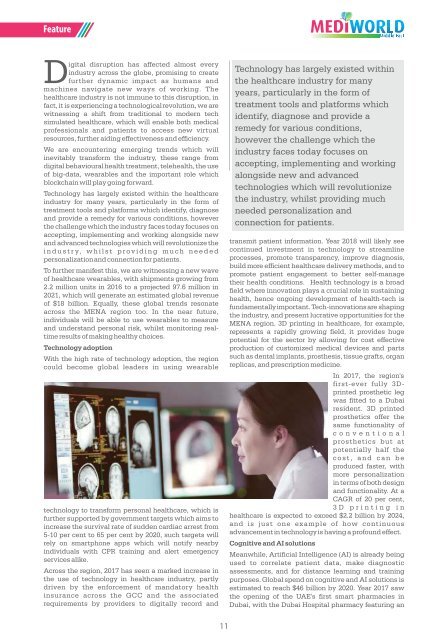Mediworld Dec JanFinal Draft for print
Create successful ePaper yourself
Turn your PDF publications into a flip-book with our unique Google optimized e-Paper software.
Feature<br />
Digital disruption has affected almost every<br />
industry across the globe, promising to create<br />
further dynamic impact as humans and<br />
machines navigate new ways of working. The<br />
healthcare industry is not immune to this disruption, in<br />
fact, it is experiencing a technological revolution, we are<br />
witnessing a shift from traditional to modern tech<br />
simulated healthcare, which will enable both medical<br />
professionals and patients to access new virtual<br />
resources, further aiding effectiveness and efficiency.<br />
We are encountering emerging trends which will<br />
inevitably trans<strong>for</strong>m the industry, these range from<br />
digital behavioural health treatment, telehealth, the use<br />
of big-data, wearables and the important role which<br />
blockchain will play going <strong>for</strong>ward.<br />
Technology has largely existed within the healthcare<br />
industry <strong>for</strong> many years, particularly in the <strong>for</strong>m of<br />
treatment tools and plat<strong>for</strong>ms which identify, diagnose<br />
and provide a remedy <strong>for</strong> various conditions, however<br />
the challenge which the industry faces today focuses on<br />
accepting, implementing and working alongside new<br />
and advanced technologies which will revolutionize the<br />
i n d u s t r y, w h i l s t p r o v i d i n g m u c h n e e d e d<br />
personalization and connection <strong>for</strong> patients.<br />
To further manifest this, we are witnessing a new wave<br />
of healthcare wearables, with shipments growing from<br />
2.2 million units in 2016 to a projected 97.6 million in<br />
2021, which will generate an estimated global revenue<br />
of $18 billion. Equally, these global trends resonate<br />
across the MENA region too. In the near future,<br />
individuals will be able to use wearables to measure<br />
and understand personal risk, whilst monitoring realtime<br />
results of making healthy choices.<br />
Technology adoption<br />
With the high rate of technology adoption, the region<br />
could become global leaders in using wearable<br />
technology to trans<strong>for</strong>m personal healthcare, which is<br />
further supported by government targets which aims to<br />
increase the survival rate of sudden cardiac arrest from<br />
5-10 per cent to 65 per cent by 2020, such targets will<br />
rely on smartphone apps which will notify nearby<br />
individuals with CPR training and alert emergency<br />
services alike.<br />
Across the region, 2017 has seen a marked increase in<br />
the use of technology in healthcare industry, partly<br />
driven by the en<strong>for</strong>cement of mandatory health<br />
insurance across the GCC and the associated<br />
requirements by providers to digitally record and<br />
Technology has largely existed within<br />
the healthcare industry <strong>for</strong> many<br />
years, particularly in the <strong>for</strong>m of<br />
treatment tools and plat<strong>for</strong>ms which<br />
identify, diagnose and provide a<br />
remedy <strong>for</strong> various conditions,<br />
however the challenge which the<br />
industry faces today focuses on<br />
accepting, implementing and working<br />
alongside new and advanced<br />
technologies which will revolutionize<br />
the industry, whilst providing much<br />
needed personalization and<br />
connection <strong>for</strong> patients.<br />
transmit patient in<strong>for</strong>mation. Year 2018 will likely see<br />
continued investment in technology to streamline<br />
processes, promote transparency, improve diagnosis,<br />
build more efficient healthcare delivery methods, and to<br />
promote patient engagement to better self-manage<br />
their health conditions. Health technology is a broad<br />
field where innovation plays a crucial role in sustaining<br />
health, hence ongoing development of health-tech is<br />
fundamentally important. Tech-innovations are shaping<br />
the industry, and present lucrative opportunities <strong>for</strong> the<br />
MENA region. 3D <strong>print</strong>ing in healthcare, <strong>for</strong> example,<br />
represents a rapidly growing field, it provides huge<br />
potential <strong>for</strong> the sector by allowing <strong>for</strong> cost effective<br />
production of customized medical devices and parts<br />
such as dental implants, prosthesis, tissue grafts, organ<br />
replicas, and prescription medicine.<br />
In 2017, the region's<br />
first-ever fully 3D<strong>print</strong>ed<br />
prosthetic leg<br />
was fitted to a Dubai<br />
resident. 3D <strong>print</strong>ed<br />
prosthetics offer the<br />
same functionality of<br />
c o n v e n t i o n a l<br />
prosthetics but at<br />
potentially half the<br />
c o s t , a n d c a n b e<br />
produced faster, with<br />
more personalization<br />
in terms of both design<br />
and functionality. At a<br />
CAGR of 20 per cent,<br />
3 D p r i n t i n g i n<br />
healthcare is expected to exceed $2.2 billion by 2024,<br />
and is just one example of how continuous<br />
advancement in technology is having a profound effect.<br />
Cognitive and AI solutions<br />
Meanwhile, Artificial Intelligence (AI) is already being<br />
used to correlate patient data, make diagnostic<br />
assessments, and <strong>for</strong> distance learning and training<br />
purposes. Global spend on cognitive and AI solutions is<br />
estimated to reach $46 billion by 2020. Year 2017 saw<br />
the opening of the UAE's first smart pharmacies in<br />
Dubai, with the Dubai Hospital pharmacy featuring an<br />
11

















